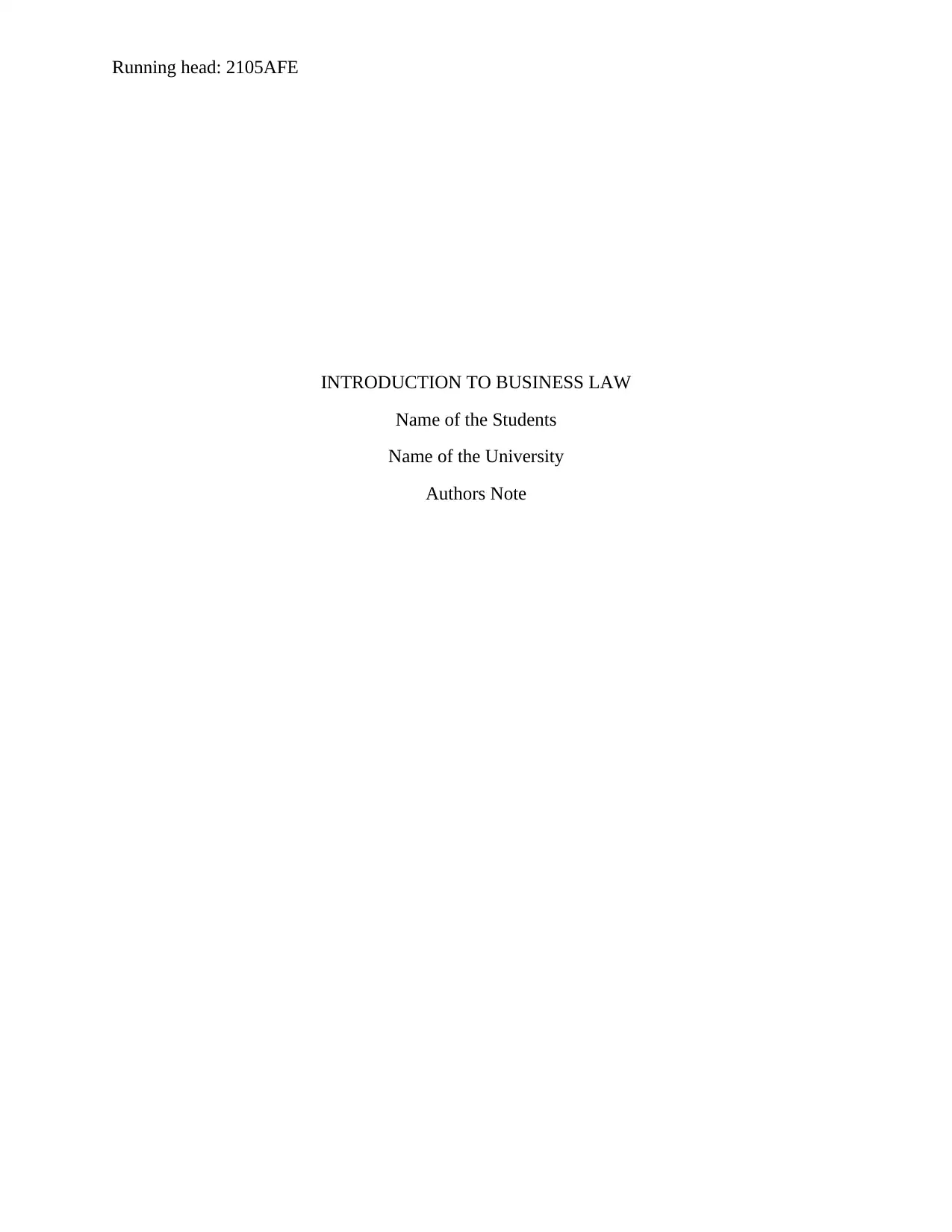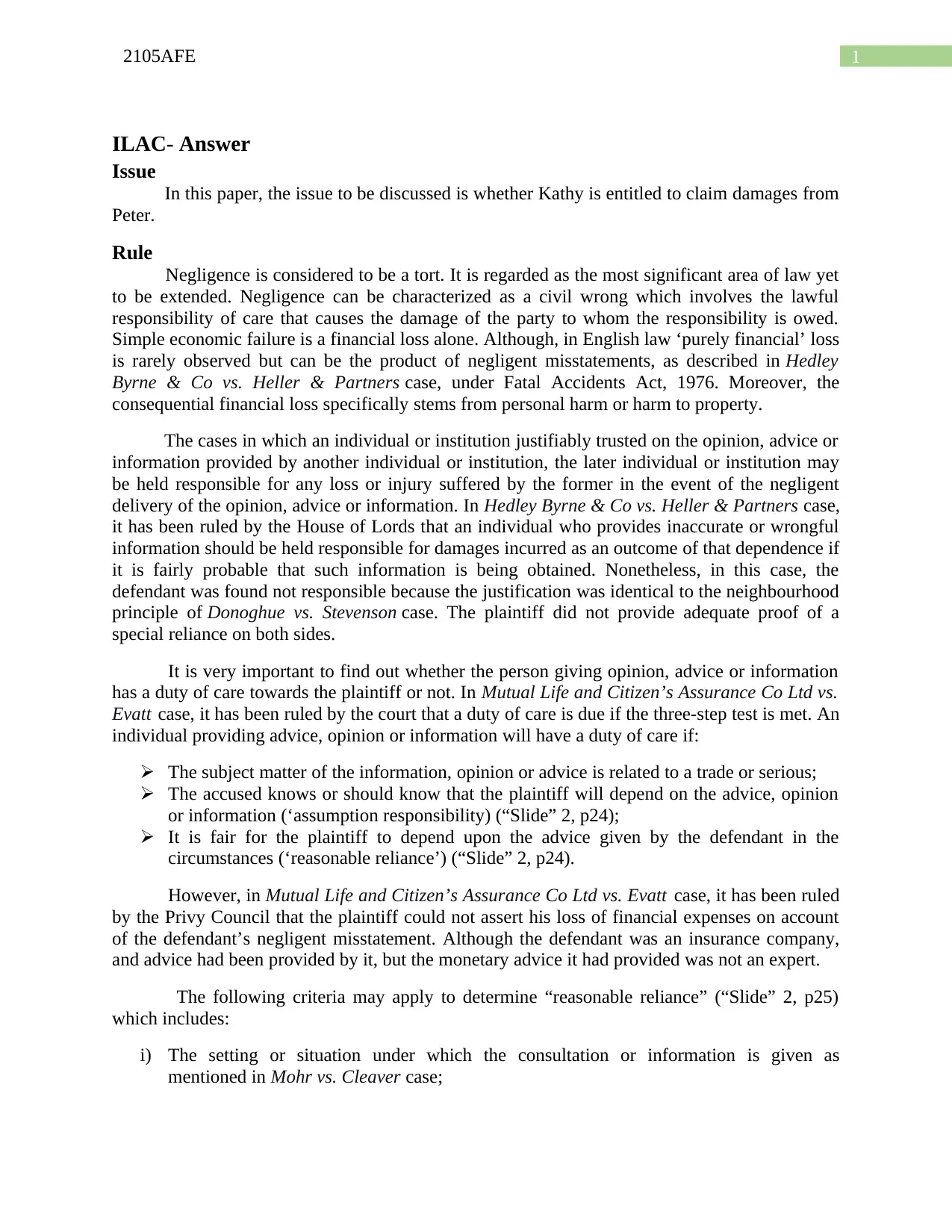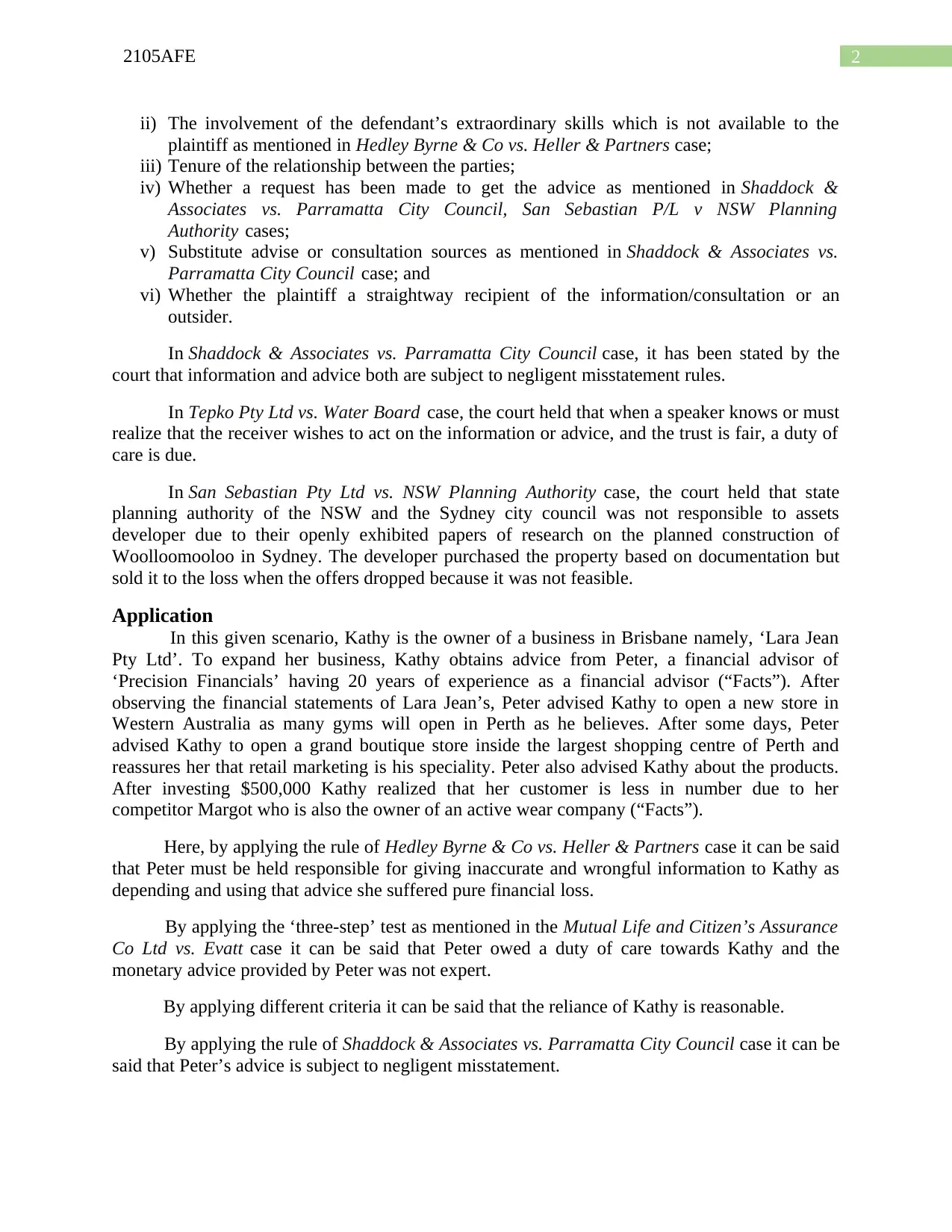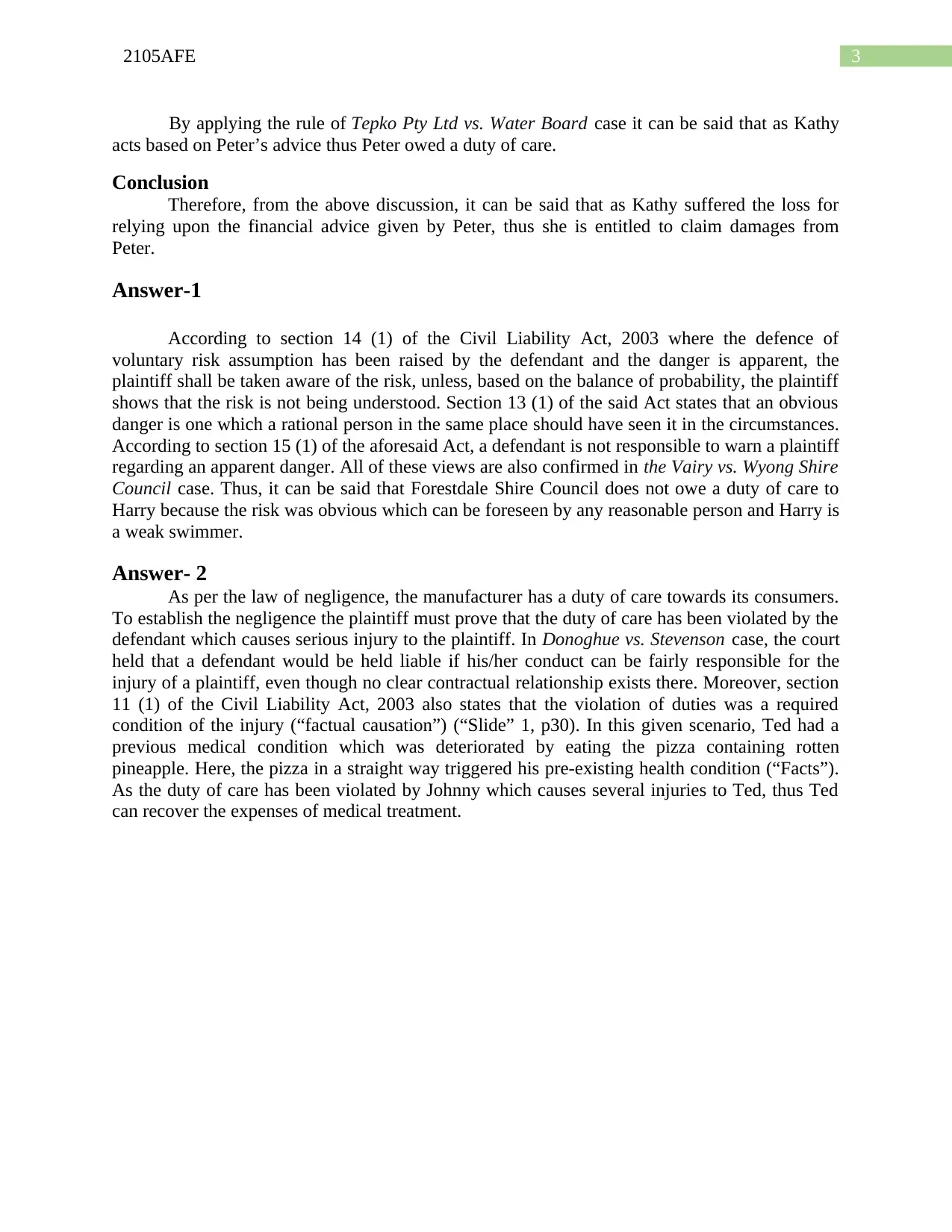Griffith University 2105AFE Business Law Problem Solving Assignment
VerifiedAdded on 2022/09/13
|4
|1585
|11
Homework Assignment
AI Summary
This document provides a comprehensive solution to a Business Law assignment, specifically addressing a problem-solving scenario based on the principles of tort law and negligence. The assignment analyzes a case involving a financial advisor's advice and its consequences, applying legal concepts such as duty of care, negligent misstatement, and the Civil Liability Act. The solution meticulously examines the elements of negligence, including breach of duty, causation, and damages, referencing relevant case law like Hedley Byrne & Co vs. Heller & Partners, Mutual Life and Citizen’s Assurance Co Ltd vs. Evatt, and Shaddock & Associates vs. Parramatta City Council. The document also includes short answer questions addressing issues of risk assumption and product liability, referencing cases such as Vairy vs. Wyong Shire Council and Donoghue vs. Stevenson. The assignment demonstrates an understanding of legal principles, case analysis, and the application of relevant legislation to real-world scenarios. The solution uses the ILAC method, breaking down the issues, rules, application, and conclusion for each question.

Running head: 2105AFE
INTRODUCTION TO BUSINESS LAW
Name of the Students
Name of the University
Authors Note
INTRODUCTION TO BUSINESS LAW
Name of the Students
Name of the University
Authors Note
Paraphrase This Document
Need a fresh take? Get an instant paraphrase of this document with our AI Paraphraser

12105AFE
ILAC- Answer
Issue
In this paper, the issue to be discussed is whether Kathy is entitled to claim damages from
Peter.
Rule
Negligence is considered to be a tort. It is regarded as the most significant area of law yet
to be extended. Negligence can be characterized as a civil wrong which involves the lawful
responsibility of care that causes the damage of the party to whom the responsibility is owed.
Simple economic failure is a financial loss alone. Although, in English law ‘purely financial’ loss
is rarely observed but can be the product of negligent misstatements, as described in Hedley
Byrne & Co vs. Heller & Partners case, under Fatal Accidents Act, 1976. Moreover, the
consequential financial loss specifically stems from personal harm or harm to property.
The cases in which an individual or institution justifiably trusted on the opinion, advice or
information provided by another individual or institution, the later individual or institution may
be held responsible for any loss or injury suffered by the former in the event of the negligent
delivery of the opinion, advice or information. In Hedley Byrne & Co vs. Heller & Partners case,
it has been ruled by the House of Lords that an individual who provides inaccurate or wrongful
information should be held responsible for damages incurred as an outcome of that dependence if
it is fairly probable that such information is being obtained. Nonetheless, in this case, the
defendant was found not responsible because the justification was identical to the neighbourhood
principle of Donoghue vs. Stevenson case. The plaintiff did not provide adequate proof of a
special reliance on both sides.
It is very important to find out whether the person giving opinion, advice or information
has a duty of care towards the plaintiff or not. In Mutual Life and Citizen’s Assurance Co Ltd vs.
Evatt case, it has been ruled by the court that a duty of care is due if the three-step test is met. An
individual providing advice, opinion or information will have a duty of care if:
The subject matter of the information, opinion or advice is related to a trade or serious;
The accused knows or should know that the plaintiff will depend on the advice, opinion
or information (‘assumption responsibility) (“Slide” 2, p24);
It is fair for the plaintiff to depend upon the advice given by the defendant in the
circumstances (‘reasonable reliance’) (“Slide” 2, p24).
However, in Mutual Life and Citizen’s Assurance Co Ltd vs. Evatt case, it has been ruled
by the Privy Council that the plaintiff could not assert his loss of financial expenses on account
of the defendant’s negligent misstatement. Although the defendant was an insurance company,
and advice had been provided by it, but the monetary advice it had provided was not an expert.
The following criteria may apply to determine “reasonable reliance” (“Slide” 2, p25)
which includes:
i) The setting or situation under which the consultation or information is given as
mentioned in Mohr vs. Cleaver case;
ILAC- Answer
Issue
In this paper, the issue to be discussed is whether Kathy is entitled to claim damages from
Peter.
Rule
Negligence is considered to be a tort. It is regarded as the most significant area of law yet
to be extended. Negligence can be characterized as a civil wrong which involves the lawful
responsibility of care that causes the damage of the party to whom the responsibility is owed.
Simple economic failure is a financial loss alone. Although, in English law ‘purely financial’ loss
is rarely observed but can be the product of negligent misstatements, as described in Hedley
Byrne & Co vs. Heller & Partners case, under Fatal Accidents Act, 1976. Moreover, the
consequential financial loss specifically stems from personal harm or harm to property.
The cases in which an individual or institution justifiably trusted on the opinion, advice or
information provided by another individual or institution, the later individual or institution may
be held responsible for any loss or injury suffered by the former in the event of the negligent
delivery of the opinion, advice or information. In Hedley Byrne & Co vs. Heller & Partners case,
it has been ruled by the House of Lords that an individual who provides inaccurate or wrongful
information should be held responsible for damages incurred as an outcome of that dependence if
it is fairly probable that such information is being obtained. Nonetheless, in this case, the
defendant was found not responsible because the justification was identical to the neighbourhood
principle of Donoghue vs. Stevenson case. The plaintiff did not provide adequate proof of a
special reliance on both sides.
It is very important to find out whether the person giving opinion, advice or information
has a duty of care towards the plaintiff or not. In Mutual Life and Citizen’s Assurance Co Ltd vs.
Evatt case, it has been ruled by the court that a duty of care is due if the three-step test is met. An
individual providing advice, opinion or information will have a duty of care if:
The subject matter of the information, opinion or advice is related to a trade or serious;
The accused knows or should know that the plaintiff will depend on the advice, opinion
or information (‘assumption responsibility) (“Slide” 2, p24);
It is fair for the plaintiff to depend upon the advice given by the defendant in the
circumstances (‘reasonable reliance’) (“Slide” 2, p24).
However, in Mutual Life and Citizen’s Assurance Co Ltd vs. Evatt case, it has been ruled
by the Privy Council that the plaintiff could not assert his loss of financial expenses on account
of the defendant’s negligent misstatement. Although the defendant was an insurance company,
and advice had been provided by it, but the monetary advice it had provided was not an expert.
The following criteria may apply to determine “reasonable reliance” (“Slide” 2, p25)
which includes:
i) The setting or situation under which the consultation or information is given as
mentioned in Mohr vs. Cleaver case;

22105AFE
ii) The involvement of the defendant’s extraordinary skills which is not available to the
plaintiff as mentioned in Hedley Byrne & Co vs. Heller & Partners case;
iii) Tenure of the relationship between the parties;
iv) Whether a request has been made to get the advice as mentioned in Shaddock &
Associates vs. Parramatta City Council, San Sebastian P/L v NSW Planning
Authority cases;
v) Substitute advise or consultation sources as mentioned in Shaddock & Associates vs.
Parramatta City Council case; and
vi) Whether the plaintiff a straightway recipient of the information/consultation or an
outsider.
In Shaddock & Associates vs. Parramatta City Council case, it has been stated by the
court that information and advice both are subject to negligent misstatement rules.
In Tepko Pty Ltd vs. Water Board case, the court held that when a speaker knows or must
realize that the receiver wishes to act on the information or advice, and the trust is fair, a duty of
care is due.
In San Sebastian Pty Ltd vs. NSW Planning Authority case, the court held that state
planning authority of the NSW and the Sydney city council was not responsible to assets
developer due to their openly exhibited papers of research on the planned construction of
Woolloomooloo in Sydney. The developer purchased the property based on documentation but
sold it to the loss when the offers dropped because it was not feasible.
Application
In this given scenario, Kathy is the owner of a business in Brisbane namely, ‘Lara Jean
Pty Ltd’. To expand her business, Kathy obtains advice from Peter, a financial advisor of
‘Precision Financials’ having 20 years of experience as a financial advisor (“Facts”). After
observing the financial statements of Lara Jean’s, Peter advised Kathy to open a new store in
Western Australia as many gyms will open in Perth as he believes. After some days, Peter
advised Kathy to open a grand boutique store inside the largest shopping centre of Perth and
reassures her that retail marketing is his speciality. Peter also advised Kathy about the products.
After investing $500,000 Kathy realized that her customer is less in number due to her
competitor Margot who is also the owner of an active wear company (“Facts”).
Here, by applying the rule of Hedley Byrne & Co vs. Heller & Partners case it can be said
that Peter must be held responsible for giving inaccurate and wrongful information to Kathy as
depending and using that advice she suffered pure financial loss.
By applying the ‘three-step’ test as mentioned in the Mutual Life and Citizen’s Assurance
Co Ltd vs. Evatt case it can be said that Peter owed a duty of care towards Kathy and the
monetary advice provided by Peter was not expert.
By applying different criteria it can be said that the reliance of Kathy is reasonable.
By applying the rule of Shaddock & Associates vs. Parramatta City Council case it can be
said that Peter’s advice is subject to negligent misstatement.
ii) The involvement of the defendant’s extraordinary skills which is not available to the
plaintiff as mentioned in Hedley Byrne & Co vs. Heller & Partners case;
iii) Tenure of the relationship between the parties;
iv) Whether a request has been made to get the advice as mentioned in Shaddock &
Associates vs. Parramatta City Council, San Sebastian P/L v NSW Planning
Authority cases;
v) Substitute advise or consultation sources as mentioned in Shaddock & Associates vs.
Parramatta City Council case; and
vi) Whether the plaintiff a straightway recipient of the information/consultation or an
outsider.
In Shaddock & Associates vs. Parramatta City Council case, it has been stated by the
court that information and advice both are subject to negligent misstatement rules.
In Tepko Pty Ltd vs. Water Board case, the court held that when a speaker knows or must
realize that the receiver wishes to act on the information or advice, and the trust is fair, a duty of
care is due.
In San Sebastian Pty Ltd vs. NSW Planning Authority case, the court held that state
planning authority of the NSW and the Sydney city council was not responsible to assets
developer due to their openly exhibited papers of research on the planned construction of
Woolloomooloo in Sydney. The developer purchased the property based on documentation but
sold it to the loss when the offers dropped because it was not feasible.
Application
In this given scenario, Kathy is the owner of a business in Brisbane namely, ‘Lara Jean
Pty Ltd’. To expand her business, Kathy obtains advice from Peter, a financial advisor of
‘Precision Financials’ having 20 years of experience as a financial advisor (“Facts”). After
observing the financial statements of Lara Jean’s, Peter advised Kathy to open a new store in
Western Australia as many gyms will open in Perth as he believes. After some days, Peter
advised Kathy to open a grand boutique store inside the largest shopping centre of Perth and
reassures her that retail marketing is his speciality. Peter also advised Kathy about the products.
After investing $500,000 Kathy realized that her customer is less in number due to her
competitor Margot who is also the owner of an active wear company (“Facts”).
Here, by applying the rule of Hedley Byrne & Co vs. Heller & Partners case it can be said
that Peter must be held responsible for giving inaccurate and wrongful information to Kathy as
depending and using that advice she suffered pure financial loss.
By applying the ‘three-step’ test as mentioned in the Mutual Life and Citizen’s Assurance
Co Ltd vs. Evatt case it can be said that Peter owed a duty of care towards Kathy and the
monetary advice provided by Peter was not expert.
By applying different criteria it can be said that the reliance of Kathy is reasonable.
By applying the rule of Shaddock & Associates vs. Parramatta City Council case it can be
said that Peter’s advice is subject to negligent misstatement.
⊘ This is a preview!⊘
Do you want full access?
Subscribe today to unlock all pages.

Trusted by 1+ million students worldwide

32105AFE
By applying the rule of Tepko Pty Ltd vs. Water Board case it can be said that as Kathy
acts based on Peter’s advice thus Peter owed a duty of care.
Conclusion
Therefore, from the above discussion, it can be said that as Kathy suffered the loss for
relying upon the financial advice given by Peter, thus she is entitled to claim damages from
Peter.
Answer-1
According to section 14 (1) of the Civil Liability Act, 2003 where the defence of
voluntary risk assumption has been raised by the defendant and the danger is apparent, the
plaintiff shall be taken aware of the risk, unless, based on the balance of probability, the plaintiff
shows that the risk is not being understood. Section 13 (1) of the said Act states that an obvious
danger is one which a rational person in the same place should have seen it in the circumstances.
According to section 15 (1) of the aforesaid Act, a defendant is not responsible to warn a plaintiff
regarding an apparent danger. All of these views are also confirmed in the Vairy vs. Wyong Shire
Council case. Thus, it can be said that Forestdale Shire Council does not owe a duty of care to
Harry because the risk was obvious which can be foreseen by any reasonable person and Harry is
a weak swimmer.
Answer- 2
As per the law of negligence, the manufacturer has a duty of care towards its consumers.
To establish the negligence the plaintiff must prove that the duty of care has been violated by the
defendant which causes serious injury to the plaintiff. In Donoghue vs. Stevenson case, the court
held that a defendant would be held liable if his/her conduct can be fairly responsible for the
injury of a plaintiff, even though no clear contractual relationship exists there. Moreover, section
11 (1) of the Civil Liability Act, 2003 also states that the violation of duties was a required
condition of the injury (“factual causation”) (“Slide” 1, p30). In this given scenario, Ted had a
previous medical condition which was deteriorated by eating the pizza containing rotten
pineapple. Here, the pizza in a straight way triggered his pre-existing health condition (“Facts”).
As the duty of care has been violated by Johnny which causes several injuries to Ted, thus Ted
can recover the expenses of medical treatment.
By applying the rule of Tepko Pty Ltd vs. Water Board case it can be said that as Kathy
acts based on Peter’s advice thus Peter owed a duty of care.
Conclusion
Therefore, from the above discussion, it can be said that as Kathy suffered the loss for
relying upon the financial advice given by Peter, thus she is entitled to claim damages from
Peter.
Answer-1
According to section 14 (1) of the Civil Liability Act, 2003 where the defence of
voluntary risk assumption has been raised by the defendant and the danger is apparent, the
plaintiff shall be taken aware of the risk, unless, based on the balance of probability, the plaintiff
shows that the risk is not being understood. Section 13 (1) of the said Act states that an obvious
danger is one which a rational person in the same place should have seen it in the circumstances.
According to section 15 (1) of the aforesaid Act, a defendant is not responsible to warn a plaintiff
regarding an apparent danger. All of these views are also confirmed in the Vairy vs. Wyong Shire
Council case. Thus, it can be said that Forestdale Shire Council does not owe a duty of care to
Harry because the risk was obvious which can be foreseen by any reasonable person and Harry is
a weak swimmer.
Answer- 2
As per the law of negligence, the manufacturer has a duty of care towards its consumers.
To establish the negligence the plaintiff must prove that the duty of care has been violated by the
defendant which causes serious injury to the plaintiff. In Donoghue vs. Stevenson case, the court
held that a defendant would be held liable if his/her conduct can be fairly responsible for the
injury of a plaintiff, even though no clear contractual relationship exists there. Moreover, section
11 (1) of the Civil Liability Act, 2003 also states that the violation of duties was a required
condition of the injury (“factual causation”) (“Slide” 1, p30). In this given scenario, Ted had a
previous medical condition which was deteriorated by eating the pizza containing rotten
pineapple. Here, the pizza in a straight way triggered his pre-existing health condition (“Facts”).
As the duty of care has been violated by Johnny which causes several injuries to Ted, thus Ted
can recover the expenses of medical treatment.
1 out of 4
Related Documents
Your All-in-One AI-Powered Toolkit for Academic Success.
+13062052269
info@desklib.com
Available 24*7 on WhatsApp / Email
![[object Object]](/_next/static/media/star-bottom.7253800d.svg)
Unlock your academic potential
Copyright © 2020–2025 A2Z Services. All Rights Reserved. Developed and managed by ZUCOL.




